In Uganda, katogo is more than sun-dried cassava and memories
Ugandan food blogger Sophie Musoki delves into the many layers of memory stirred up by a dish of simple, humble katogo.
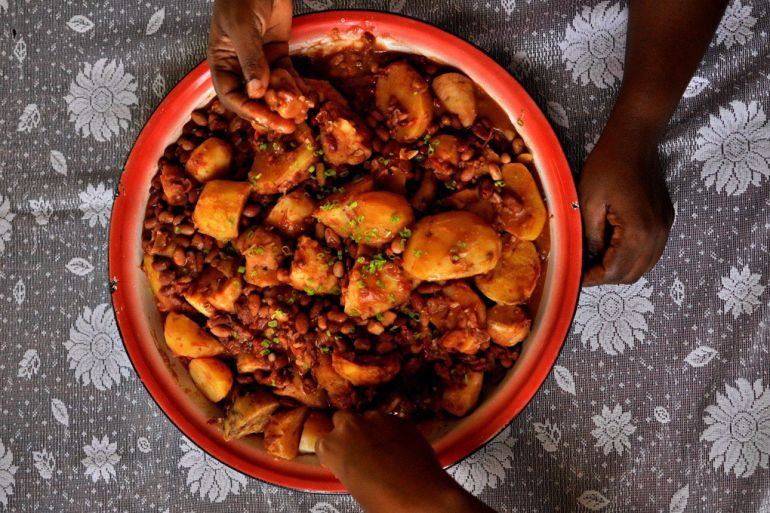
“We have two more bunches,” I shouted so that my younger sister, who was in the other room, could hear me as I carried two hands of fresh green bananas (locally known as matooke) from the front door to the kitchen. It was the second time that week that we had received bananas from generous neighbours and now we had a heap of four hands to eat our way through.
Preparing green bananas for cooking is a tedious process, so I suggested we sit on the verandah to peel them while we still had daylight as it was late in the afternoon. Armed with the best knives we could find, my sister and I sat down, put on a podcast, and started peeling the bananas. The plan was to peel all of them and then store them in the refrigerator to be used for katogo later; prepping, as most cooks will tell you, is everything.
Keep reading
list of 4 itemsRevisiting molokhia amid war and displacement in Gaza
Maqali, a simple Syrian dish that saved a displaced family’s Ramadan iftar
The Sikh kitchen that feeds Manila’s moneylenders
As I haphazardly, unevenly, peeled one finger – something that was expected, especially if you are still considered an amateur – I remembered the many times that I, as a clumsy child, watched my mother peel matooke to make katogo with effortless grace. Her process was a rhythmic flourish between hands, knife and banana fingers. She would do more than just grip the knife, she gently held it in position, just so, so the peels glided off the bananas in an impressive swoop.
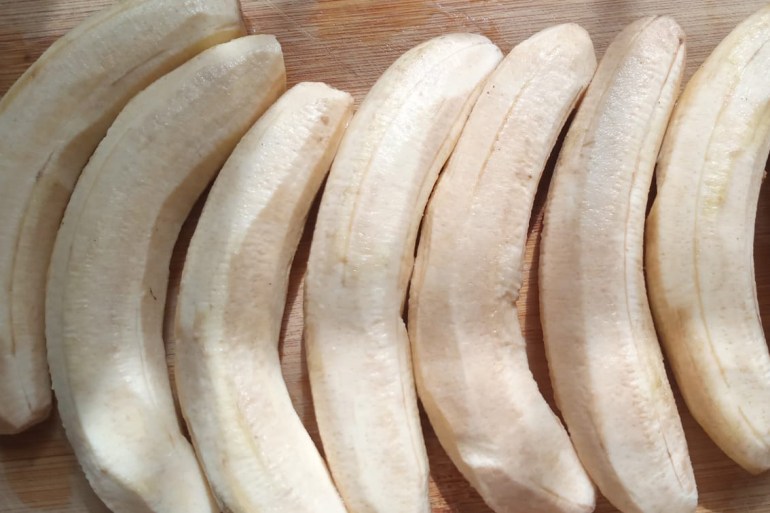
My greatest desire as a child at that time was to grow up so I could know how to peel matooke perfectly, like my mother. That was how we learned to cook, that was how knowledge in general, and food knowledge in particular, was handed down through the generations. You watched a lot, then practised and practised until you knew how to do it.
As a curious child, that was how I learned the food knowledge that would kick-start my interest in food and eventually food storytelling. Fast forward to now, I love talking about food, writing about it, cooking it, photographing it, and eating it.
‘Eh, katogo just!’
Today, if you were to ask me what meal I am most likely to eat for the rest of my life, I will always choose katogo, that simple Ugandan dish I watched my mother and grandmother make so many times as a child. It is very adaptable, it gives me – and any cook really – room to experiment with it and to work with either whatever ingredients are readily available or new ones that I want to try out.
I think I knew that as a child because I paid close attention to how that simple dish – of a starch cooked down with either a protein or a vegetable together in one pot into a rich pottage-like meal – is made.

Even though it is commonly perceived as a simple, basic dish, katogo is an anything and everything-goes meal that is so much more than just mixing ingredients together. In just one bite, the composition of the dish can tell you a lot about the cook, the season, or the place you are eating it.
The word katogo itself is derived from various Bantu languages in Uganda and directly translates to “a mixture or mélange of things” in English. Originally, katogo is known to have consisted of cassava cooked with beans. In parts of Uganda where Irish potatoes are grown a lot, it is more likely to find katogo made with Irish potato as the main starch, and areas where matooke is consumed the most will have matooke instead of cassava. Occasionally, yams and sweet potatoes are used too.
“Katogo” has made its way out of the kitchen too, and the word can also be used to describe non-food items and situations in Uglish – which is the local urban dialect that mixes English, Luganda, and sometimes Swahili. For example, if you are attending a concert and it looks disorganised and chaotic, you would simply say “Eh, that concert is katogo just!”
Woven baskets of cassava
My earliest memory of cassava and beans katogo was on the yearly trips my family took to our grandparents’ homes in Kasese in western Uganda. As soon as I was big enough, I would help out with harvesting the cassava that was going to be preserved for the year. We would pick the fresh cassava right out of the ground and fill our woven baskets with it, then we would carry them home on our heads or backs.
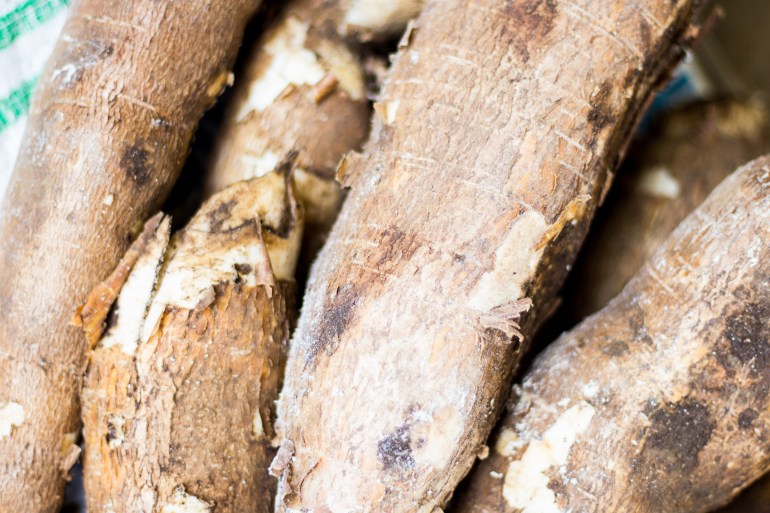
At home, the cassava would be cleaned, peeled, sliced and laid out to sun-dry. As they dried, the whole house would be surrounded by a lingering, slightly fermented aroma that I absolutely loved. In fact, all the houses in the area would have that same aroma as well.
When completely dried, the cassava pieces would be ground into a flour that is used to make the popular cassava and millet (and sometimes sorghum) swallow called Obundu or A kalo in western Uganda and Kwon kal in northern Uganda. A swallow is a cooked, starchy dough-like side dish that is kneaded or mixed until it reaches the consistency the cook prefers and is then eaten with rich, hearty stews.
Some of the fresh cassava was destined for the katogo, and I would watch attentively as my mother’s mother took a portion of that harvested cassava, peeled and cut it into bite-sized chunks and then put them in a pot and boiled them. She would then add about 2 – 3 handfuls of already cooked beans to the boiling cassava, add coarse salt to taste, and let the katogo cook down into a rich mixture as the cassava steeped in the soup from the beans.
She worked with such an effortless method that could only be attributed to countless years of cooking this food, in this way. In less than an hour, a meal would be ready to serve with a side of steamed greens. It was such a simple dish, but the freshness of the cassava and beans cooked down in a clay pot rendered a unique flavour.
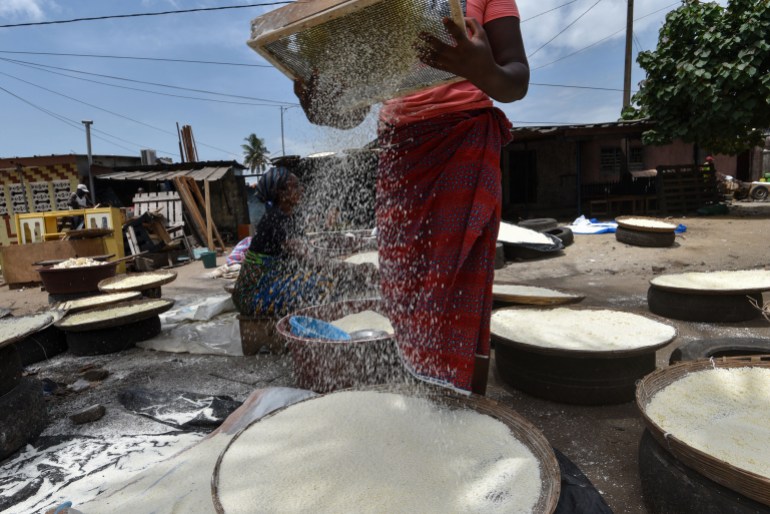
Later, when we moved to Kampala in central Uganda, I found out that this simple mixture of cassava and beans is sometimes served with a side of ghee. The addition of ghee alone will have anyone who tastes this meal asking for seconds.
Because it is a mixture of a starch and a protein, katogo can be cooked with any ingredients, depending on what you prefer. Among the accompaniments to the base starch that I have seen in katogo are beans, beef stew, offal, groundnut stew, a rich tomato stew or really any other stew you may desire.
Potato-peanut katogo
My fascination with food led me to start a food blog in 2014, through which I was able to explore more the process of preparing food and how mixing different ingredients will always yield something unique. It is an online journal for me to chronicle my experiences in the kitchen, share what I have learned, and interact with fellow food enthusiasts out there.
It has grown since, evolved into an archive of hundreds of recipes based on local ingredients and into a community of foodies who also tune in to my very own podcast, Our Food Stories – another place to tell Ugandan food stories, past and present, so we can keep the memory of those who passed these stories on to us alive.
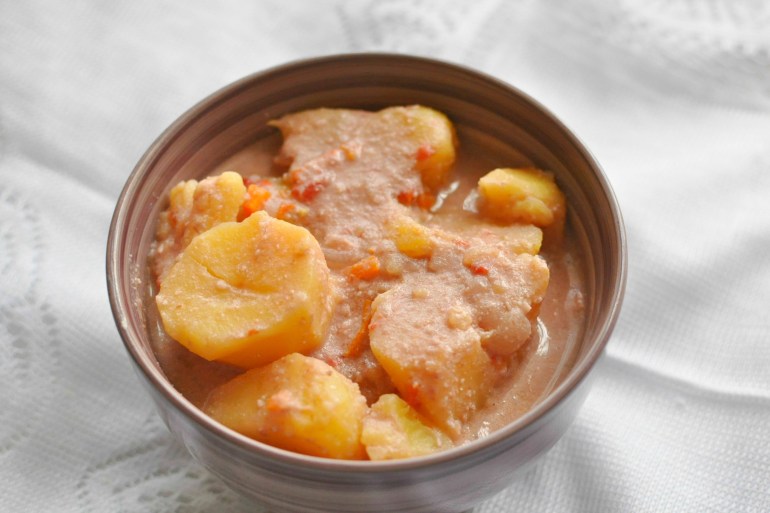
I have three katogo recipes on my blog, one is for a simple Irish potato, groundnut and tomato version, the second has sweet potatoes, yams and potatoes with a more intricate sauce and beans, and the third one is the classic matooke katogo. The recipes are basic and clear, because they leave room for you to add whatever you like. Beans, meat, tofu, anything goes.
The origins of katogo are unknown, but it has been cooked for ages and every region, in fact, every household, will have its own version that varies depending on the ingredients available, the season, and the level of convenience.
When my family and I stayed in Kampala, we had access to a lot of groundnuts – or peanuts – simply because this is an ingredient that is used in a variety of dishes in the central part of the country. The groundnuts are roasted and ground into either a flour or a paste that is used for dishes such as groundnut stew, which pairs exceptionally well with mashed matooke cooked wrapped up in a banana leaf. We also had an abundance of Irish potatoes which are a common food for most urban dwellers.
Like many parts of the continent, The Cambridge World History of Food shares that the Irish potato – the same variety that featured in the Irish potato famine brought about by a mould infestation in the crop – was introduced to Uganda through European missionaries and colonisers. Since the potato tubers could be stored in the ground, their popularity grew in war-torn areas. The crop is grown mainly in the highlands of the western region of Uganda and transported to Kampala for consumption.
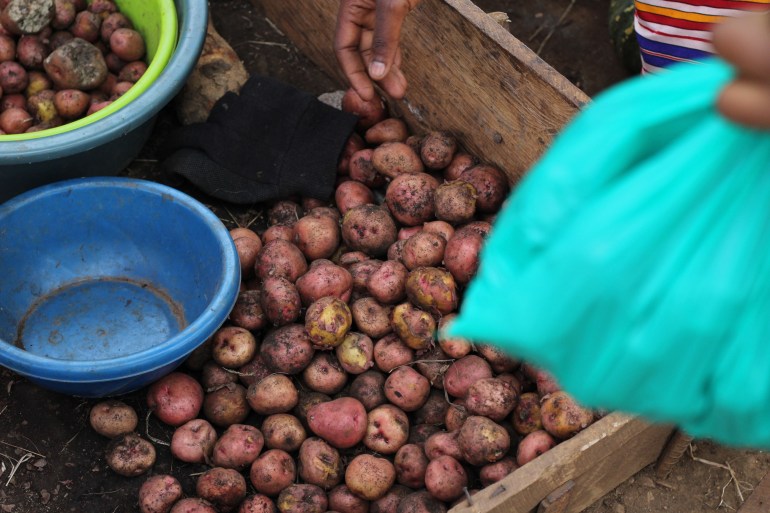
Because we had an abundance of potatoes and peanuts, we enjoyed making and eating Irish potato and groundnut paste katogo, the first recipe I shared on my blog.
Making this version of katogo is easy, as easy as washing and peeling your potatoes, cutting them to the size you desire and then bringing them to a boil. Once the potatoes are parboiled, dissolve the groundnut paste into a small bowl of water to create a runny porridge-like consistency. Then add the groundnut paste mixture, salt, and curry powder to the boiling potatoes and let the katogo simmer till cooked down. Whenever we wanted to elevate the flavour of our katogo, we would fry chopped onions, garlic, and tomatoes in oil and then add the potatoes and let them cook in the oily aromatics before adding the groundnut paste mixture.
This kind of katogo was one of the many dishes I had to learn to make as a rite of passage for a Ugandan girl-child. As soon as I learned how to make this katogo – at about 10 years of age – I started taking over the responsibility for cooking meals for my younger siblings from my mother.
Potato-groundnut katogo is best served with a glass of chilled passion fruit juice and kachumbali (a salad of thinly sliced tomatoes and red onions).
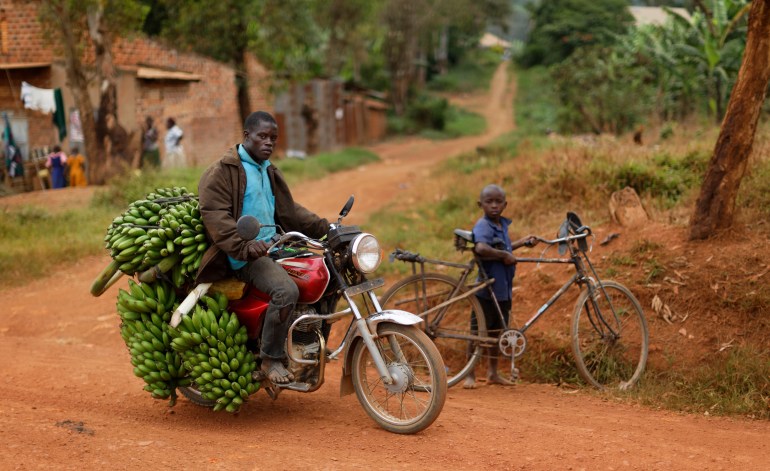
‘Poor man’s food’
About 20 years ago, give or take, katogo was largely considered “poor man’s food”. My father once told me that this was because cassava was introduced to the Ugandan diet as a famine-fighting crop.
Because of that, most people didn’t want to be seen eating katogo, fearful that it would imply poverty or struggle. But, with urbanisation and the busy lifestyle that is most people’s reality today, the dish has reemerged as a meal that is convenient, easy to make, and very filling.
In newer versions, matooke has replaced cassava and meat or offal have replaced beans, especially in cities. Stroll around downtown Kampala and you will find katogo offered in many breakfast joints and in quite a few high-end restaurants. Of course, each establishment adds its own spin to it.
Most of our dishes in Uganda are generally slow foods that require a lot of preparation and cooking time. Take the chicken luwombo, a great example.
First of all, note that it would not be an authentic luwombo if the chicken has not been roasted on an open flame to infuse a smoky flavour into the meat. To make chicken luwombo, you have to slaughter the chicken (if it is a local breed) and dress it. The next step is to cut the chicken into pieces, if you prefer it cut up, and chop the accompanying vegetables and aromatics: onions, tomatoes, peppers, potatoes, carrots, whatever you have on hand.

You then have to prepare the luwombo pouches, which are made out of tempered tender banana leaves. To temper banana leaf, put the clean leaves in the sun for at least 20 minutes till they become limp, then smoke them gently and take out the leaf ribs. Make sure you don’t tear the leaves, they won’t work as well if you do. You need leaves to wrap the chicken, more leaves to wrap the pouches of chicken, and still more to line the pot they will be cooked in.
Once the leaves are ready, the chicken is wrapped up in the luwombo pouches along with the accompanying vegetables and aromatics and tied well. Then the pouches are wrapped again and put into the lined pot and sealed. Then comes the cooking part, where the fire’s temperature has to be monitored so that the chicken is fully cooked through but doesn’t burn. This whole process can take anywhere from 3 to 6 hours.
Compare chicken luwombo with the simple katogo process of just “throwing everything in a pot” and simmering, and you will see what makes katogo the go-to meal for most people who need a quick, hearty dish.
Put the matooke in the katogo
Before you start to make matooke katogo, make sure that you’ve oiled your hands and the knife you will be using to peel the green bananas because, otherwise, the sap will stick to both and stain them.
To make katogo for a crowd, peel 10-15 green bananas, putting them in a bowl of water to avoid excessive oxidation as you work. Once you’re done, wash your hands and get a clean pan on medium heat and add 1 teaspoon of oil. Once the oil has warmed up, add chopped onions and garlic and let them cook till translucent.
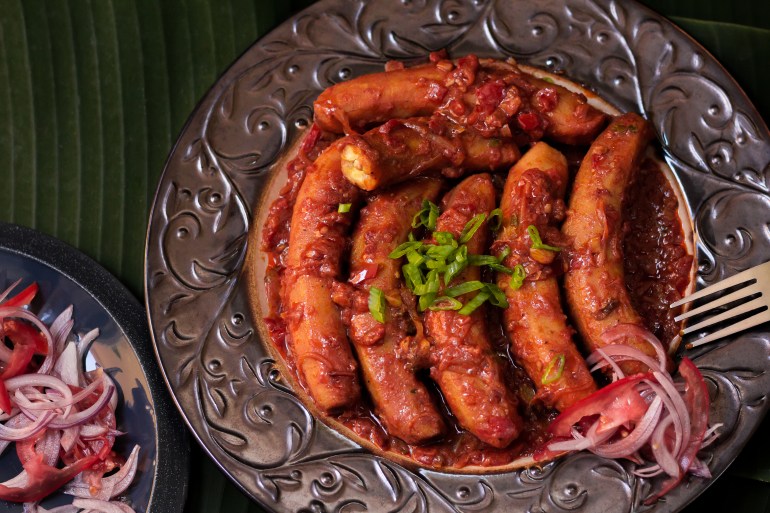
Next, add 5-7 chopped tomatoes to the onions – the tomatoes are going to be the stew, so add as many as you would like to have sauce at the end. Add salt, Royco (a popular spice mix in Uganda, you can use any other spice mix you prefer), and curry powder, and let the tomatoes cook till tender and jammy. If you find that the tomatoes are a bit tart and acidic, sprinkle a bit of sugar and mix it through to soften the flavour.
Add the bananas to the pan with enough water to nearly cover them. The amount of water you add to the katogo will determine the consistency. More water will make it mushy and soupy and vice versa. Let the katogo boil till the bananas are almost tender. Add black pepper to taste.
Once the katogo starts becoming tender, reduce the heat and let it braise and simmer in the tomatoes until it has reduced down and produced a rich red tomato stew. Remove from the heat and serve with ghee, a side of sliced avocado, and spicy ginger tea if the weather is cold.
Better yet, make a pot of katogo and keep it overnight to eat in the morning when the flavours have married well and intensified.
Even though I am yet to master the art of peeling matooke, I still do it and I don’t let it deter me from continuing to celebrate and eat katogo and its many variations.